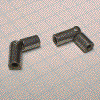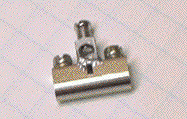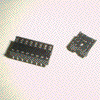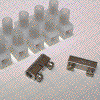|
|
BEAM Pieces is a BEAM Reference Library site.
Miscellaneous parts
Odds and ends
There are a bunch of parts which are handy for building your 'bot, but didn't really fit into any of the previous pages' categories.
IC sockets are wonderful things for three reasons:
- Sockets keep you from accidentally overheating ICs during soldering (you solder to the socket, and plug the IC in later).
- Sockets allow for easy replacement of ICs if you "let the smoke out" of one.
- Sockets are cheap (they only cost a few cents each).
Note that you can avoid the clutter of noise-filtering capacitors (between Vcc and ground legs of your ICs) if you buy IC sockets with power filtering capacitors built in (tho' filtering sockets cost about $2 US each, vs. a few cents for "plain" sockets).
These allow you to "roll your own" ICs; I use 8-pin headers as "plugs" (and 8-pin IC sockets as the "jacks") whenever I use small cables to interconnect various parts of a 'bot.
PC Board hinged standoffs 
![]() (1/4" grid)
(1/4" grid)
These make great hinges for small robot legs.
These can be tough to find, but yield nifty little metal parts that provide a great way to mount legs to a variety of motors via either solder or epoxy. These are my preferred way of mounting legs to walkers -- the metal bits have two screws, so they're great for attaching two separate legs to a motor (makes assembly easier). If you're in the U.S., Radio Shack sells these under the name "European style junction strips" (in two sizes, "regular," and "jumbo" -- I use the "regular" ones).Occasionally I either bugger up the screw head, or need more torque when tightening it -- you can replace these screws (for the "regular" strips, anyway) with 3mm screws with a head of your choosing (I prefer an "Allen" style for really high torque capability).
You can find these in most electronics stores; as with the junction strips, these yield a little metal part that is good for mounting legs to motor shafts. Note the single "tightening" screw; you need to either solder / epoxy a pair of legs to this metal bit (and then use the screw to "grab" the motor shaft), or else solder / epoxy this metal bit to your motor shaft (and then use the screw to "grab" a single leg assembly).
Note that if you're mounting legs to a motor with a bare shaft, you can solder a terminal block core to a junction strip core to yield a great mounting block:

|
|
||
|
|
This page was last updated on |
|



